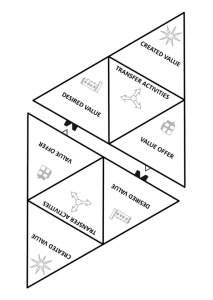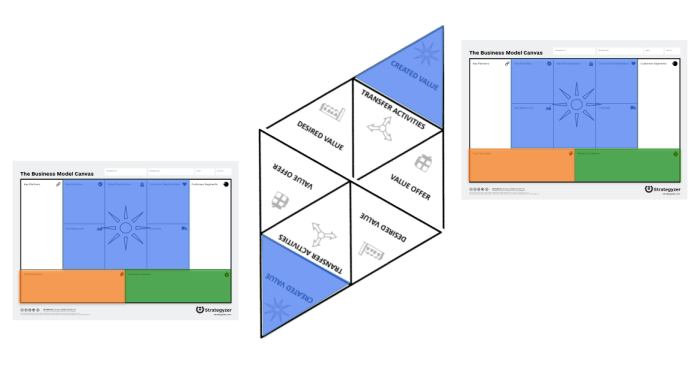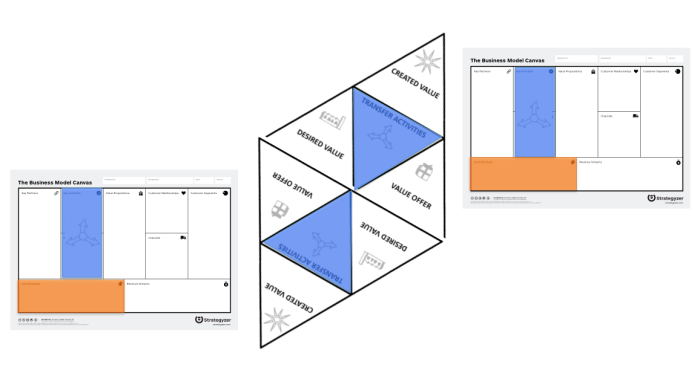This article the second in part of a series, which was published on LinkedIn (read the first one here). It comes from a collaboration between:
Bart Doorneweert (Partner at Source Institute, and Guest Lecturer Entrepreneurship, Business Model Innovation at Wageningen University)
and
Wim Vanhaverbeke (Professor at Hasselt University, and Visiting Professor at ESADE Business School)
When working on changing a business model, partnerships are one amongst an alternative of paths you can choose. In this blog post we will discuss when it starts making sense to pursue the path of a partnership as a way forward. We’ll also discuss how to structure the design process. We’ll do that, by using the partnership canvas in combination with the business model canvas. Lastly, we’ll close off with thoughts on how to define some of the critical hypotheses around impact to your business model, and setting the balance right for value capture for both partners.
First questions about partnership intent
The drive for business model innovation always starts with the customer. The question is how the customer experience can be expanded, or deepened through changes to the business model, eg. new features to the product, convenience in delivery, new pricing/payment options, etc.
Based on this idea, the next question is how to operationalize this change. Does the company go for it alone, or will it require a partnership to best effectuate the business model change? To consider whether having a partner on board makes sense or not, we’ve designed the partnership intent puzzle. The following questions need to be asked:
Functionality: do customers expect you to create and deliver it?
Market sizing: is your addressable market large enough?
Time to market: is time to market pressing, and can you launch quickly enough?
Resources: do you have the skill set, time, and budget to develop the functionality internally?
These are the essential 4 factors you need to consider, to determine whether you’re in the most suitable position to launch an innovation yourself, or whether you need a partner. By defining the type of innovation you’re looking for, and the need for a partner, you have a solid definition of intent for your partnership.
The partnership design process
Defining intent will be the starting point for searching, and shortlisting potential partners. These partners will need to meet the initial criteria you have defined around the innovation you want to achieve for your customers (eg. a new channel to reach a new audience, a new production resource to make your product more affordable, or ramp up production volumes, etc).
Based on this shortlist, your design process will start to find out whether you can make a match with a partner. This partnership design process consists of four steps, which we’ll go through below:
Understand
You will need to map out each business model of your potential partners to understand how their business currently works. Then, in the same way that you have defined your intent, the question is what could be the intent for your partner to collaborate. What can you spot regarding constraints they’re struggling with, or an opportunity they can’t quite grasp? By taking time to analyze each of the partners’ business models, both sides of the table will have an understanding where each party is coming from.

Design
Once you understand your intended partner’s business model, and they understand yours, then you can begin to design a partnership structure. This explains what you think is your perspective on a potential partnership. Your partner will also create their version of the story.
You can use the partnership canvas for designing the partnership story in combination with your, and your partner’s business model (leaf through the slides above). Your value offer should be based on what’s present in your business model. The desired asset is a quality that your partner would possess. Created value relates to what you need for your business model (it is already defined by your intent definition). Lastly, to round off the partnership logic, you need to define how you will make these values mutually accessible through the transfer activities.
Compare
The critical phase in the partnership discussion is to create alignment between your partner and yourself on the partnership. Is the value that you offer something that your partner is looking for in you, and is the value you desire from a partner something that this partner is willing to offer? And, lastly, can you come to an agreement on how you will grant mutual access to these values through the transfer activities?

By mirroring the partnership canvasses, each representing a perspective from each partner, you will have that critical discussion to see if you can reach alignment. It is also a step where you might surprise each other about some new idea to add to the collaboration, something you wouldn’t have conceived of on your own.
Evaluate
After alignment has been created on the partnership structure, an evaluation needs to take place about the impact that the partnership will have on each partner’s business model. Without a satisfactory impact to both partners, the partnership will likely dissipate. Therefore, doing the check to define clear hypotheses about the partnership, and making sure that both partners understand them, is crucial.
To understand the impact of the partnership, you need to lay out both partners’ business models, and the partnership. With this overview, the following aspects need to be evaluated, namely (1) the value check, and (2) the cost check:
-
- Where does the created value from the partnership add to each business model? What will its effects be? For instance creating an additional channel will bring in new customers, and likely generate an increase in revenue. Or creating an addition to your value proposition enables you to upsell your products, and command a higher price in the market. Trace the upside for each partner, and make these assumptions explicit
 Likewise you will also need to evaluate the flipside of the partnership. The partnership might entail that you need to do something extra to activate the new value that is created for your business model. Will you require extra investment or incur extra costs on your end to activate this value, or not?
Likewise you will also need to evaluate the flipside of the partnership. The partnership might entail that you need to do something extra to activate the new value that is created for your business model. Will you require extra investment or incur extra costs on your end to activate this value, or not?
- Where does the created value from the partnership add to each business model? What will its effects be? For instance creating an additional channel will bring in new customers, and likely generate an increase in revenue. Or creating an addition to your value proposition enables you to upsell your products, and command a higher price in the market. Trace the upside for each partner, and make these assumptions explicit
-
- Running a partnership can sometimes require significant costs for a business. These costs are located within the transfer activity of the partnership. To estimate this cost-effect, you have to ask yourself whether the transfer activity will have a significant effect to your business model’s key activities, and resources. If so, will you bear the full costs for it? Or, can you get your partner to compensate you, or is there some other way you can share the load? Important questions for creating an equitable relationship.

- Running a partnership can sometimes require significant costs for a business. These costs are located within the transfer activity of the partnership. To estimate this cost-effect, you have to ask yourself whether the transfer activity will have a significant effect to your business model’s key activities, and resources. If so, will you bear the full costs for it? Or, can you get your partner to compensate you, or is there some other way you can share the load? Important questions for creating an equitable relationship.
The power of the partnership canvas
If the exercise mentioned above comes out positive, you will have arrived at a foundation of your partnership agreement. Both sides of the table will have a clear conception of what their contribution will be, how it will work, and what they will get out of it. Innovation can now be achieved through making two business models operate in interdependence.
Ideally a partnership will not require too much cost or investment from either of the partners to operationalize it. However, it could turn out that there is an in imbalance between the partners. One partner could turn out to require a lot of investment in the partnership or is not able to capture much of the value, while the other partner has comparatively little costs, and investment to make, and stands to gain a lot from the deal. Such imbalance could break the partnership opportunity.
Regardless of the outcome, the key asset of the partnership canvas is that it allows you to figure out these details at an early stage. You can design experiments, and judge the potential of a partnership, even before it has been formally negotiated and implemented. The exercise above can be done as a simulation session with your team, preparing for a partnership discussion. But you can also do this with your actual partner in the room, and jointly sculpt the deal. For the full summary, you can download the partnership design process slides.
Interested to learn more about Partnership Design?
Check out Training opportunities!
or
You can join the Partnership Design Linkedin group!
Further inquiries? Send an email to: info@partnershipcanvas.com
